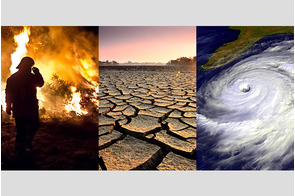Climate Refugees are human face of global warming

Summary
State of the World 2015 investigates hidden threats to sustainability, including economic and environmental challenges.
The State of the World 2015 report has revealed that between 2008 and 2013, about 140 million people were displaced by weather-related disasters. Apart from this alarming figure, which is about the entire population of South Africa, Tanzania and Kenya combined, gradual displacements, such as those caused by droughts or sea-level rise, affected the lives of countless others. Such "climate refugees," the report says, have become the human face of global warming. Moreover, their movement is seen as a threat to global security.
Produced by the Worldwatch Institute, the State of the World 2015 investigates hidden threats to sustainability, including economic, political, and environmental challenges that are often underreported in the media. The report highlights the need to develop resilience to looming shocks.
The report critiques current policies which see migration as an impending humanitarian catastrophe and as a failure to adapt to changing environments back home. As a result of the limitations of these policies, focus is usually on reducing migration, by assuming that overwhelming flows of migrants from poor countries will flood to the industrialized countries.
Contributing author of the report and executive director of the Politics of the Earth programme, Sciences Po in Paris, Francois Gemenne, said Current migration policies aim to reduce the number of people who are forced to migrate, while ignoring those who might in fact prefer to leave but are forced to stay against their will or ability. "Extending the migration options of populations...would require a broader development agenda," Gemenne said.
People who would choose to migrate face many barriers, including the high financial cost, which sometimes costs several years' worth of a migrant's savings. Moving also comes with various administrative barriers, such as the possible loss of social benefits and protection. The lack of information about employment and the competition for land at the destination can also limit people's ability to relocate.
But in holistically addressing climate-induced migration, Gemenne, who is also a senior research associate with the University of Liège in Belgium, proffers two policy directions. The first is to provide migration opportunities for the most vulnerable populations, including improving access to resources, information, and networks to allow them to relocate. The second is to adapt destinations, such as urban areas in developing countries, to host and integrate communities of migrants.
"The paramount goal of policy responses should be to enable people's right to choose which adaptation strategy is best suited for their needs," Gemenne said. "This implies that people should be entitled with both the right to stay and the right to choose."
Related
-
Nigeria's climate progress after COP28
Access Bank, as a key player in the financial sector, has been playing a key role in supporting Nigeria's climate finance ...
-
Elon Musk unveils details of $100mn global carbon reduction competition
We want teams that will build real systems that can make a measurable impact and scale to a gigaton level -- Musk.
-
Nigeria needs a bold response to climate change
Current and projected average temperatures in Africa are higher than the global average.







